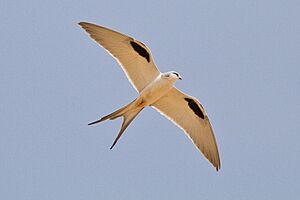Scissor-tailed kite facts for kids
The scissor-tailed kite (Chelictinia riocourii), also known as the African swallow-tailed kite or fork-tailed kite, is a type of bird of prey. It belongs to the Accipitridae family, which includes eagles, hawks, and other kites. This bird is the only species in its special group, called Chelictinia. You can find it across the northern tropical parts of Africa.
Quick facts for kids Scissor-tailed kite |
|
|---|---|
 |
|
| Flying in Far North Region, Cameroon | |
| Conservation status | |
| Scientific classification | |
| Genus: |
Chelictinia
|
| Species: |
riocourii
|
Contents
About Its Name
The scissor-tailed kite was first drawn and described by scientists in the early 1800s. A Dutch zoologist named Coenraad Jacob Temminck helped illustrate it in 1821. Later, a French ornithologist, Louis Pierre Vieillot, also described it.
In 1843, a French naturalist named René Lesson decided this bird was unique enough to have its own special group, or genus, called Chelictinia. The name Chelictinia might come from ancient Greek words meaning "swallow" and "kite." This refers to how it looks and flies, similar to a swallow.
The second part of its scientific name, riocourii, honors a French count named Rioucour. He was known for having a beautiful collection of birds.
What It Looks Like
The scissor-tailed kite is a small and slender bird. It has a pale grey back and white belly. Its head is broad, and it has long, pointed wings. A key feature is its deeply forked tail, which looks like scissors.
Adult birds have a white forehead and a black patch around their eyes. When they fly, their dark grey flight feathers stand out against the lighter parts of their wings. They also have bright red eyes, which are easy to spot.
Young scissor-tailed kites are a bit darker on their backs. Their feathers might have reddish-brown edges. They are also a creamier color underneath. This bird flies in a unique way, almost like a tern. It can also hover in the wind, much like a kestrel.
Where It Lives
This kite lives in the dry grasslands, called savannah, of the Sahel region in Africa. You can mostly find it in a strip of land between 8° and 15° North latitude. This area stretches from Senegal on the west coast all the way to Sudan in the east. There are also groups of these birds living in Ethiopia and Kenya.
The scissor-tailed kite is found in many African countries. These include Benin, Burkina Faso, Cameroon, Chad, Ethiopia, Ghana, Kenya, Mali, Niger, Nigeria, Senegal, Sudan, and Togo. It can also be found in Yemen.
How It Lives
Diet and Hunting
When they are raising their young, scissor-tailed kites mostly eat skinks and other small lizards. They also hunt small snakes, rodents, and insects like arthropods.
These kites usually hunt while flying. They sometimes chase insects that are disturbed by grass fires. When many termites or locusts appear, you might see many scissor-tailed kites gathering to eat them. They have also been seen flying near cattle, catching insects that the animals stir up.
Reproduction and Nesting
Scissor-tailed kites often breed in small groups, or colonies, with up to 20 pairs. However, they can also breed as single pairs. In most areas, they breed from May to August. In western parts of their range, they breed from December to February, and in Kenya, from March to June or August.
They build a small nest out of sticks. These nests are often found in acacia trees or thorny bushes, usually 2 to 8 meters (about 6 to 26 feet) off the ground. Sometimes, they build their nests close to the nests of larger birds of prey, like a secretary bird or a brown snake eagle. They might even build nests near buildings.
Status
The scissor-tailed kite is considered a Vulnerable species. This means its population is decreasing, and it could be at risk of disappearing. Things like changes to their habitat and the use of pesticides can harm them. Even with these challenges, some areas still have many scissor-tailed kites.

